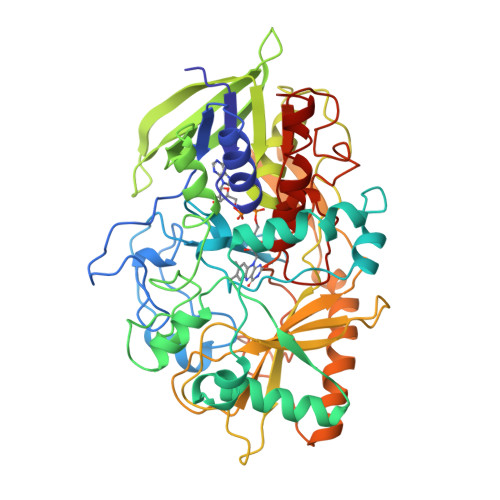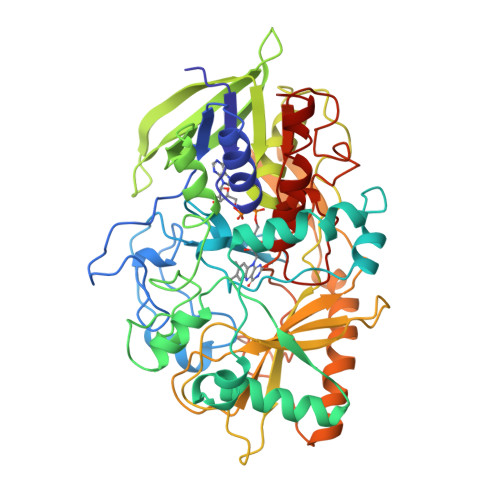Crystal structure determination of cholesterol oxidase from Streptomyces and structural characterization of key active site mutants.
Yue, Q.K., Kass, I.J., Sampson, N.S., Vrielink, A.(1999) Biochemistry 38: 4277-4286
- PubMed: 10194345
- DOI: https://doi.org/10.1021/bi982497j
- Primary Citation of Related Structures:
1B4V, 1B8S, 1CBO, 1CC2 - PubMed Abstract:
Cholesterol oxidase is a monomeric flavoenzyme which catalyzes the oxidation and isomerization of cholesterol to cholest-4-en-3-one. The enzyme interacts with lipid bilayers in order to bind its steroid substrate. The X-ray structure of the enzyme from Brevibacterium sterolicum revealed two loops, comprising residues 78-87 and residues 433-436, which act as a lid over the active site and facilitate binding of the substrate [Vrielink et al. (1991) J. Mol. Biol. 219, 533-554; Li et al. (1993) Biochemistry 32, 11507-11515]. It was postulated that these loops must open, forming a hydrophobic channel between the membrane and the active site of the protein and thus sequestering the cholesterol substrate from the aqueous environment. Here we describe the three-dimensional structure of the homologous enzyme from Streptomyces refined to 1.5 A resolution. Structural comparisons to the enzyme from B. sterolicum reveal significant conformational differences in these loop regions; in particular, a region of the loop comprising residues 78-87 adopts a small amphipathic helical turn with hydrophobic residues directed toward the active site cavity and hydrophilic residues directed toward the external surface of the molecule. It seems reasonable that this increased rigidity reduces the entropy loss that occurs upon binding substrate. Consequently, the Streptomyces enzyme is a more efficient catalyst. In addition, we have determined the structures of three active site mutants which have significantly reduced activity for either the oxidation (His447Asn and His447Gln) or the isomerization (Glu361Gln). Our structural and kinetic data indicate that His447 and Glu361 act as general base catalysts in association with conserved water H2O541 and Asn485. The His447, Glu361, H2O541, and Asn485 hydrogen bond network is conserved among other oxidoreductases. This catalytic tetrad appears to be a structural motif that occurs in flavoenzymes that catalyze the oxidation of unactivated alcohols.
Organizational Affiliation:
Biochemistry Department, McGill University, Montréal, Québec, Canada.

















